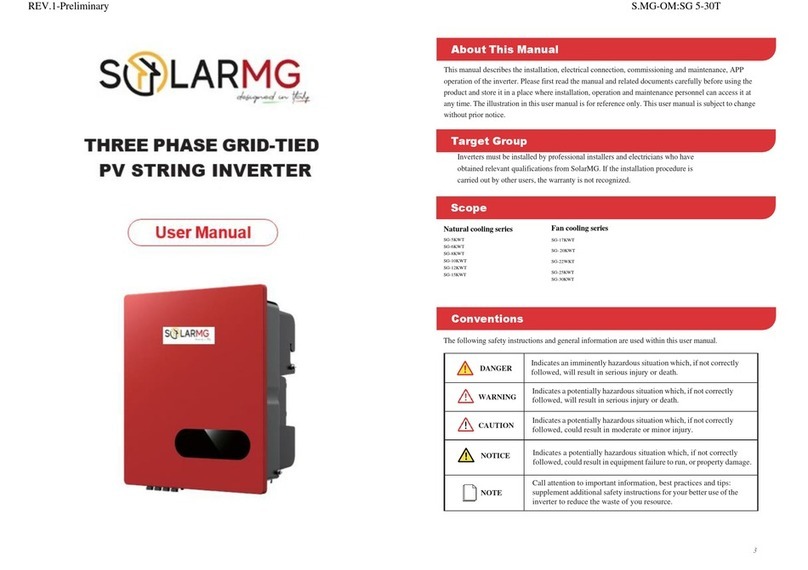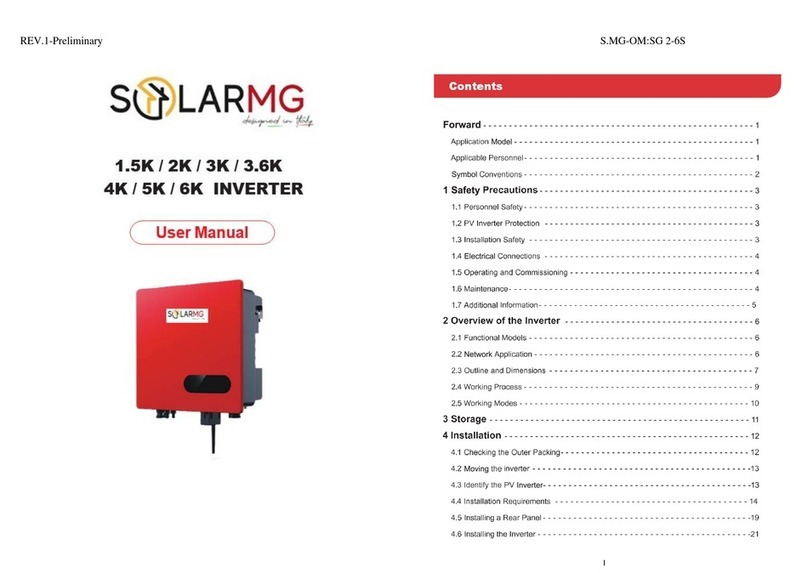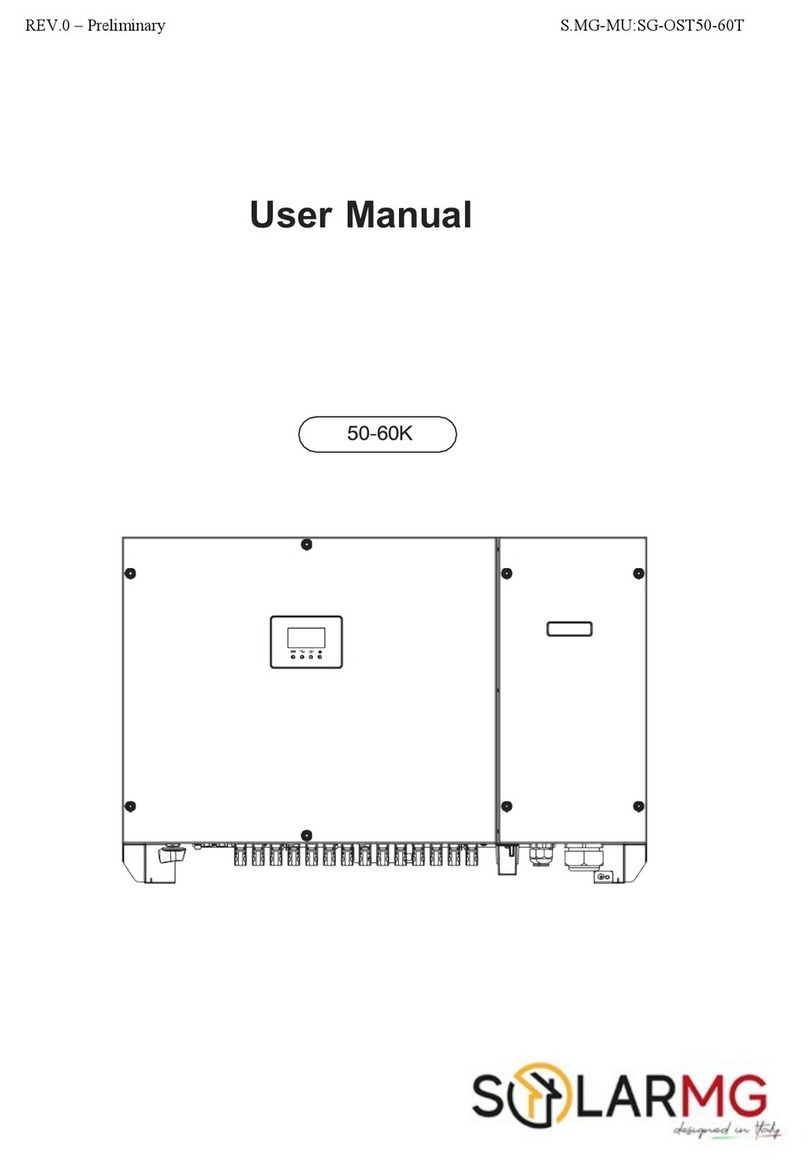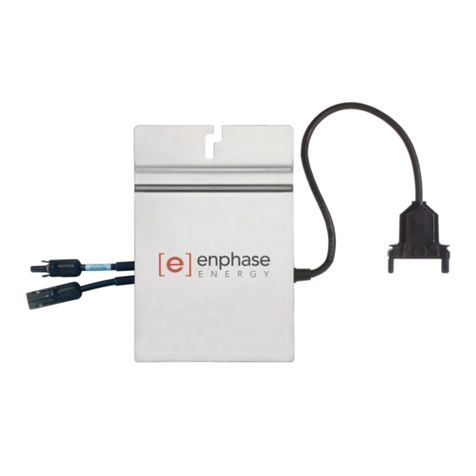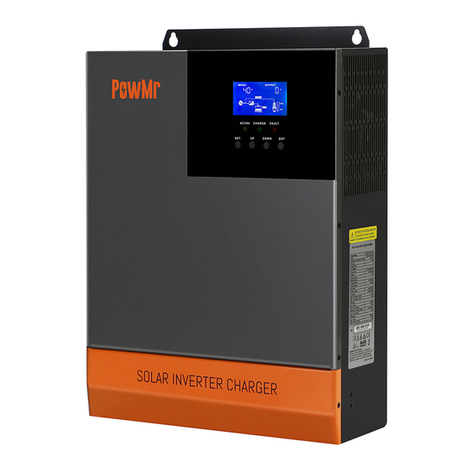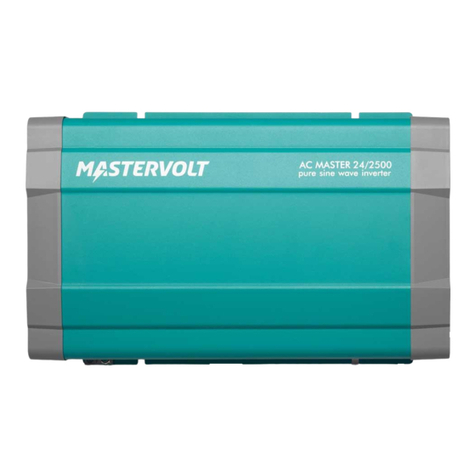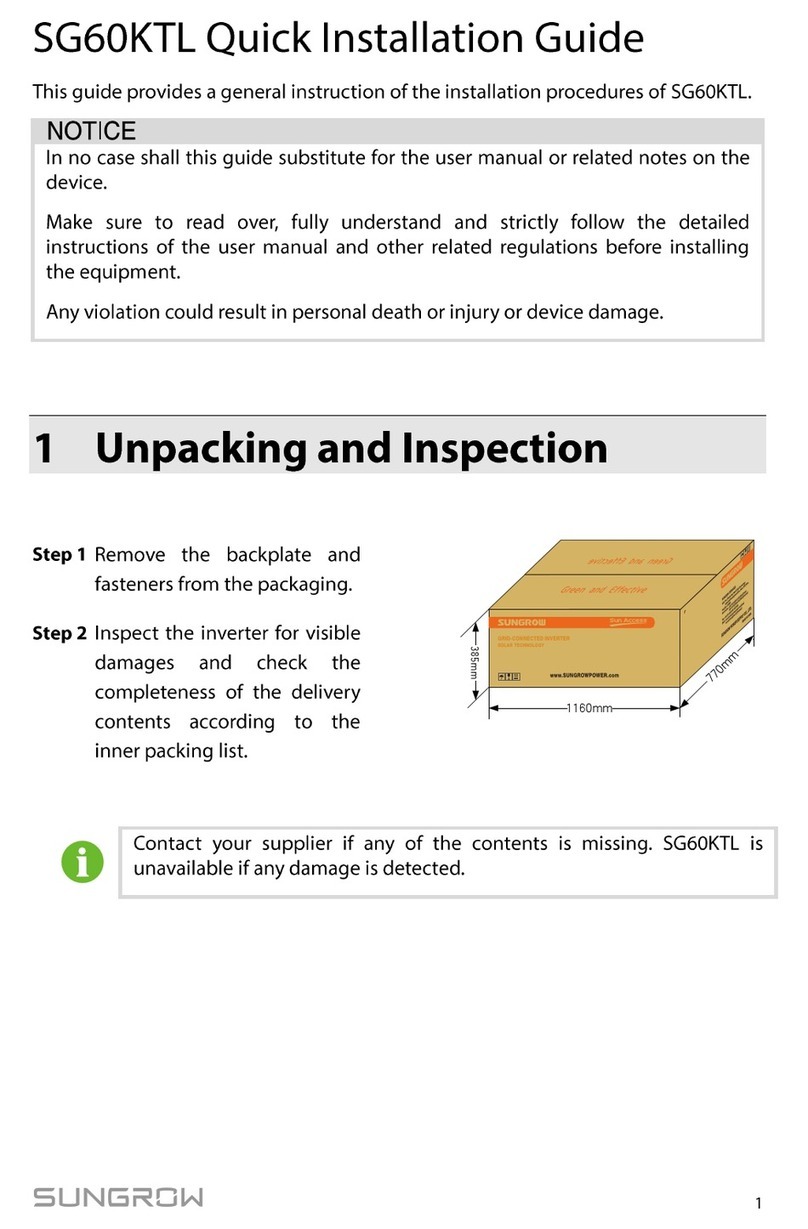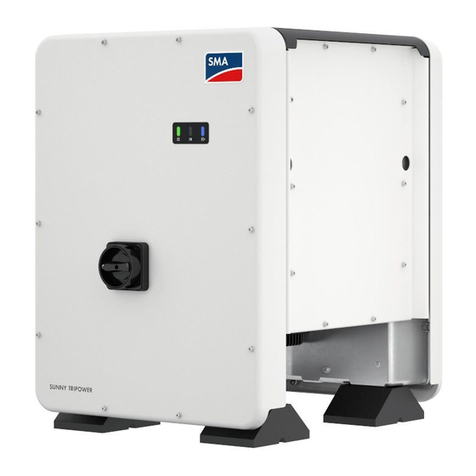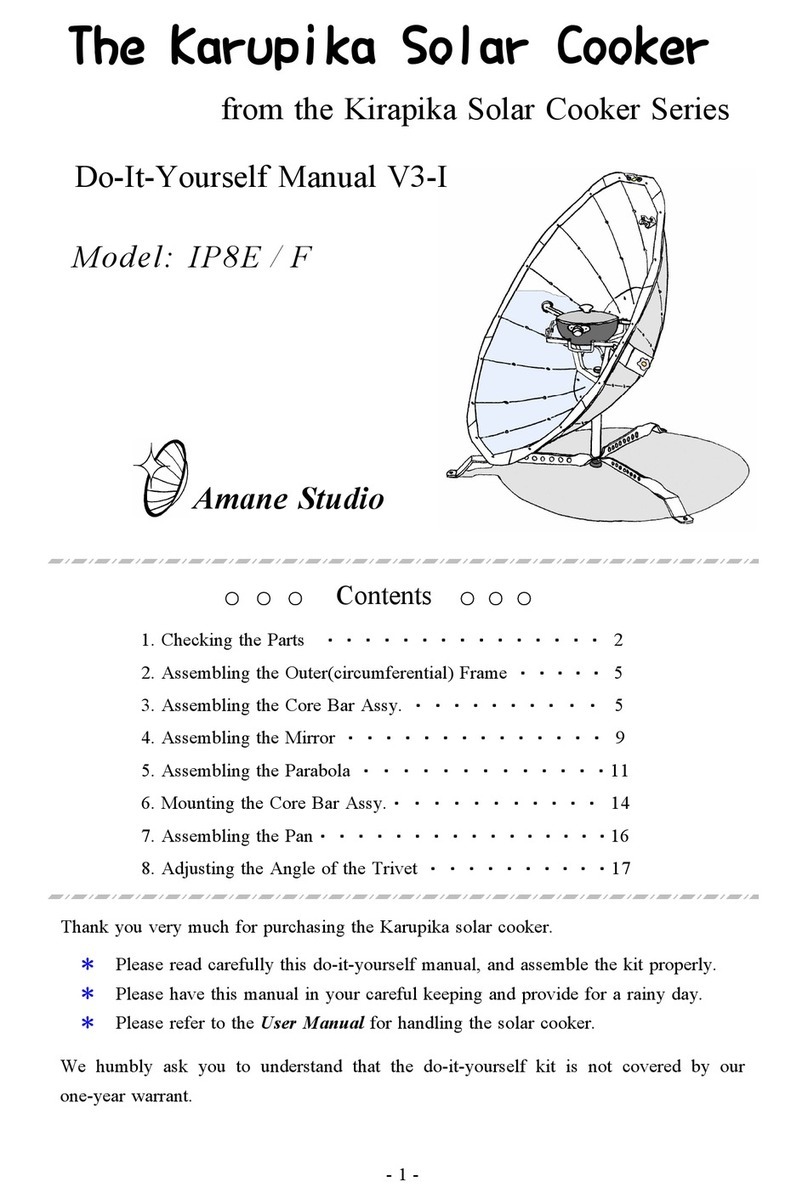SOLARMG SG-5KWHBT User manual

3
REV.1 –Preliminary S.MG-OM:SG 5-10HBT
THREE PHASE HYBRID INVERTER
5KW/6KW/8KW/10KW
User Manual
Target Group
Scope
This manual describes the installation, connection, the use of APP, commissioning and maintenance
etc. of three phase hybrid inverter. Please first read the manual and related documents carefully before
using the product and store it in a place where installation, operation and maintenance personnel can
access it at any time. The illustration in this user manual is for reference only. This user manual is subject
to change without prior notice. (Specific please in kind prevail.)
Three phase hybrid inverters must be installed by professional electrical engineers who have obtained
relevant qualifications.
This manual is applicable to following inverters:
SG-5KWHBT
SG-6KWHBT
SG-10KWHBT
The following safety instructions and general information are used within this user manual.
DANGER
Indicates an imminently hazardous situation which, if not correctly
followed, will result in serious injury or death.
WARNING
Indicates a potentially hazardous situation which, if not correctly
followed, will result in serious injury or death.
CAUTION
Indicates a potentially hazardous situation which, if not correctly
followed, could result in moderate or minor injury.
NOTICE
Indicates a potentially hazardous situation which, if not correctly
followed, could result in equipment failure to run, or property
damage.
NOTE
Call attention to important information, best practices and tips:
supplement additional safety instructions for your better use of the
Three phase hybrid inverter to reduce the waste of you resource.
Conventions
About This Manual

4
REV.1 –Preliminary S.MG-OM:SG 5-10HBT
Preface
About This Manual
Target Group
Scope
Conventions
1. Safety
1.1 Symbols Used
1.2 Safety Precaution
2. Product Introduction
2.1 Overview
2.2 Product Appearance
2.3 Model Definition
3. Installation
3.1 Packing List
3.2 Selecting the Mounting Location
3.3 Mounting
4. Electrical Connection
4.1 Grounding
4.2 GRID/BACKUP Connection
4.3 Battery Connection
4.4 PV Connection
4.5 Meter/CT Connection
4.6 Communication Connection
5. System Operation
5.1 Inverter Working Mode
5.2 Startup/Shutdown the System
6. Commissioning
6.1 Inspection
6.2 Commissioning Procedure
7. User Interface
7.1 LED
7.2 App Setting Guide
8. Maintenance
8.1 Routine Maintenance
8.2 Inverter Troubleshooting
8.3 Removing the Inverter
9. Technical Specifications
10.Technical Assistance
Contents
Contents

6
7
REV.1 –Preliminary S.MG-OM:SG 5-10HBT
Before using the inverter, please read all instructions and cautionary markings on the unit and manual.
Put the instructions where you can take them easily.
The three phase hybrid inverter of ours strictly conforms to related safety rules in design and test. Local
safety regulations shall be followed during installation, operation and maintenance. Incorrect operation
work may cause injury or death to the operator or a third party and damage to the inverter and other
properties belonging to the operator or a third party.
1.1 Symbols Used
1.2 Safety Precaution
Installation,maintenance and connection of inverters must be performed by qualified personnel, in
compliance with local electrical standards, wiring rules and requirements of local power authorities
and/or companies(for example: AS 4777 and AS/NZS 3000 IN Australia).
To avoid electric shock, DC input and AC output of the inverter must be terminated at least 5 minutes
before performing any installation or maintenance.
The temperature of some parts of the inverter may exceed 60℃ during operation. Do not touch the
inverter during operation to avoid being burnt and let it cool before touching it.
Ensure children are kept away from inverters.
Don’t open the front cover of the inverter. A part from performing work at the wiring terminal (as
instructed in this manual), touching or changing components without authorization may cause injury
to people, damage to inverters and annulment of the warranty.
Static electricity may damage electronic components. Appropriate method must be adopted to prevent
such damage to the inverter; otherwise the inverter may be damaged and the warranty annulled.
Ensure the output voltage of the proposed PV array is lower than the maximum rated input voltage of
the inverter; otherwise the inverter may be damaged and the warranty annulled.
When exposed to sunlight, the PV array generates dangerous high DC voltage. Please operate according
to our instructions, or it will result in danger to life.
PV modules should have an IEC61730 class A rating.
If the equipment is used in a manner not specified by the manufacturer, the protection provided by the
equipment may be impaired.
Completely isolate the inverter before maintaining. Completely isolate the inverter should: Switch off
the PV switch, disconnect the PV terminal, disconnect the battery terminal, and disconnect the AC
terminal.
Prohibit to insert or pull the AC and DC terminals when the inverter is running.
In Australia, the inverter internal switching does not maintain the neutral integrity, neutral integrity must
be addressed by external connection arrangements.
In Australia, the output of backup side in switchbox should be labeled main switch UPS supply, the
output of normal load side in switchbox should be labeled mains switch inverter supply.
Don’t connect Three phase hybrid inverter in the following ways:
BACKUP Port should not be connected to grid;
The single PV panel string should not be connected to two or more inverters.
Safety Symbol
Description
Danger of high voltage and electric shock!
Only qualified personnel may perform work on the inverter.
5 mins
Danger of high voltage. Residual voltage in the inverter need
5 mins to discharge, wait 5 mins before operation.
Danger of hot surface
Do not disconnect under load! (Fire danger)
Environmental Protection Use Period
Refer to the operating instructions
Product should not be disposed as household waste.
Grounding terminal

8
9
REV.1 –Preliminary S.MG-OM:SG 5-10HBT
530.0
213
LED Details
The External View of Hybrid Inverter
PV BAT GRID BACKUP COM ALARM
LEDIndicators
2.1 Overview
Hybrid Inverter
The hybrid inverters are high-quality inverter which can convert solar energy to AC energy and store
energy into battery.
The inverter can be used to optimize self consumption, store in the battery for future use or feed into
public grid. Work mode depends on PV energy and user’s preference. It can provide power for emergency
use during the grid lost by using the energy from battery and inverter (generated from PV).
2.2 Product Appearance
2.2.1 Hybrid Inverter
Width(mm)
Height(mm)
Depth(mm)
530
550
213
Grid
PV
Inverter
Sensor
Normal Load
Monitoring
Device
Cloud
Critical Load
Sensor and Normal Load are optional.
Battery
Hybrid Inverter Application System
3 6 9 10
13 14 16 17
19 21 24 25
1 4 7 10
550.0
637.8

10
11
REV.1 –Preliminary S.MG-OM:SG 5-10HBT
SG-6KW HBT
Three phase
Hybrid
Power(6000W)
Hybrid Inverter
3.1 Packing List
After unpacking, please check the following packing list carefully for any damage or missing parts. If
any damage or missing parts occurs, contact the supplier for help.
2.3 Model Definition
The letters in the product model have the specific informations.
( Take 6KHB-T as example.)
3
Installation
1
8
2 3 4 5 6 7
The bottom view of hybrid inverter
1. PV Switch
2. PV Input Terminals
3. Battery Connect Terminals
4. COM1 Ports
( RS485, BMS, DRMs/RCR, CT,
NTC/DI/DO, RSD/RMO, PARAL)
5. COM Port
(WIFI/LAN)
6. BACKUP Output Terminal
7. Grounding Terminal
8. GRID Output Terminal
A
B
C
D
E
F
G
Or
H
I
J
K
L
M
N
O
3
6
9
10
131416 17 19 21 2425
1
4
7
10
Number
Quantity
Description
A
1
Inverter
B
1
Mounting bracket
C
1
File package
D
3/3
PV terminal connector group (PV+/PV-) ;
E
2
Grid/BACKUP connector
F
1/1
Battery terminal connector group (BAT+/BAT-) ;
G
1
Meter (Optional)
H
3
CT
I
3
M12 Expansion screws
J
1
M6 Security screw
K
1
WIFI/LAN module (Optional)
L
1
9-Pins terminal
M
1
6-Pins terminal
N
2
4-Pins terminal
O
1
Removal tool for PV/BAT connector

12
13
REV.1 –Preliminary S.MG-OM:SG 5-10HBT
≤15°
Upright
Lean back ≤15°
Upside-down
Horizontally
3.2 Selecting the Mounting Location
3.2.1
Installation Environment Requirements
a. The storage inverter protection class is IP65 and can be mounted indoors or outdoors.
b. The mounting location must be inaccessible to unrelated personnel since the enclosure and heat sinks
are extremely hot during operation.
c. Do not install the storage inverter in areas containing highly flammable materials or gases.
d. To ensure optimum operation and long service life, the ambient temperature must be below 50℃.
e. The storage inverter must be mounted in a well ventilated environment to ensure good heat dissipation.
f. To ensure long service life, the storage inverter must not be exposed to direct solar irradiation, rain,
or snow. It is recommended that the inverter be mounted in a sheltered place.
g. The carrier where the inverter is mounted must be fire-proof. Do not mount the inverter on flammable
building materials.
h. Do not install the inverter in a rest area since it will cause noise during operation.
i.
The installation height should be reasonable and make sure it is easy to operate and view the display.
j. Product label and warning symbols shall be clear to read after installation.
k. Please avoid direct sunlight, rain exposure, show lay up install.
3.2.2
Mounting Requirements
Mount the inverter vertically or tilted backward by max 15°. The device can not be installed
with a wrong mode and the connection area must point downward.
3.2.3
Installation Space Requirements
To ensure the inverter normally and easy to operate, there are requirements on available spaces of the
inverter, e.g. to keep enough clearance. Refer to the following figures.
No direct sunlight No Rain Exposure No snow lay up
Snow lay up
Direct Sunlight
Rain Exposure
≥500 Above: 500mm
Below: 600mm
Front: 1000mm
Left side: 350mm
Right side: 350mm
≥600
350mm
350mm
Installation along the same line for multiple inverter

14
15
REV.1 –Preliminary S.MG-OM:SG 5-10HBT
Expansion screw group
(M12;3 suites)
E D C B
A
A & B
Hold the wall bracket horizontally
in position as a template.
Mark the holes position
on the wall.
Drill the holes.
M12
26N·m
3 × M12 Expansion screw; 26N·m
f
e
d
M6 Security screw; 2.5N·m
c
b
a
Ø: 16mm; Depth: 55mm
3.3 Mounting
Before mounting the inverter, you have to prepare
expansion screws and security screw.
Step 1. Install the mounting bracket
1. Use a level ruler to mark the position of the 3 holes on
the wall. Refer to Figure a. And drill 3 holes, 16mm in
diameter and 55mm in deep. Refer to Figure b.
2. Knock the expansion screw kit into the hole together
with a hammer. Refer to Figure c.
Note: Do not remove the nut unit in this step.
3. After tightening 2-3 buckles, the expansion bolts are
tight and not loose, and then unscrew the bolts, spring
washer, gasket. Refer to Figure c.
4. Install and fix the mounting bracket on the wall.
Refer to Figure d.
493.4
14.0
160.0
320.0 Unit: mm
This chapter shows the details connection of Three phase hybrid inverter. The following illustration
only uses the hybrid inverters as an example.
Three phase hybrid inverter system connection diagram:
Connection mode for whole-house load
Step 2. Install the inverter on the mounting bracket. Then lock the inverter using the security
screw. Refer to Figure e, Figure f.
DANGER
Before frilling the hole on the wall, ensure no damage on the electric wire
and/or water pipe inside the wall.
CAUTION
To prevent potential damages and injuries from inverter falling down,
please hang the inverter on the bracket, do not loosen grip unless confirm
the inverter is well mounted.
PV Array
PE
N
Lithium battery/
lead-acid battery
PE
Load
③
PE
Grid
PARA
CT1+
GND
CT2+
GND
CT3+
GND
NTC
GND
DI
DO2
BMS
③
DO1
DRMS
RMO
RSD
RS485
Note:
1. BMS communication connection is only for lithium battery.
2. Meter is optional.
3. About breakers:
DC breaker on BATTERY side: 80A
AC breaker on load side ≥40A
AC breaker on Grid side ≥40A
COM
L1
L2
L3
N
PE
Breaker
4
Electrical Connection
92.0
10.0
25.0
Pin 1 2 4 5

16
17
REV.1 –Preliminary S.MG-OM:SG 5-10HBT
1
CT1+
No.2 Inverter
GND
PARA
ON CT2+
GND
CT3+
GND
NTC
GND
DI
DO2
①
BMS
③
PV Array
DO1
DRMS
PE
RMO
RSD
RS485
①
③
No.1 Inverter
PV Array
①
③
Lithium battery/
lead-acid battery
1
Turn this switch
CT1+
to “ON”.
②
Critical Load
CT
PARA
GND
ON
CT2+
GND
②
CT3+
GND
NTC
GND
DI
DO2
BMS
①
③
Normal Load
CT3
CT2
DO1
DRMS
RMO
RSD
CT1
RS485
Flow from Grid
to Inverter.
Or
Meter
PARA
1
CT1+
CT
or
Meter
GND
Turn this switch
to “ON”.
ON CT2+
GND
CT3+
GND
3
6
9
10
NTC
GND
DI
DO2
BMS
①
③
SG-T670
(80A)
DO1
DRMS
RMO
RSD
RS485
②
* These communication cables can be connected to
COM
L1
L2
L3
N
1
4
7
10
①Parallel communication connection
②CT/Meter communication connection
③BMS communication connection
Grid
inverter and we call this inverter No. 1 inverter.
Remark: Meter or CT both are optional.
any inverter, but they must be inserted into the same PE
Breaker
Turn this switch
to “ON”.
2 32 5 35 8 38 11 12
1314 1617 1921 24 25
Non-parallel connection mode
Three phase parallel connection mode-Scheme A (N=2)
Ensure that inverter and all cables to be installed are completely powered
off during whole installation and connection. Otherwise, fatal injury can
occur due to the high voltage.
DANGER
Normal Load
PV Array
PE
PE
1000:1(50A)
N
Lithium battery/
lead-acid battery
PE
Critical Load
CT1
CT2
③
PE
CT3
Grid
②
CT
or
Meter
PARA
②
(CT)
CT1+
GND
CT2+
GND
CT3+
GND
25
24
NTC
GND
DI
DO2
BMS
③
DO1
DRMS
RMO
RSD
RS485
②
(Meter)
Note:
COM
1. BMS communication connection is only for lithium battery.
2. Meter or CT are both optional.
3. About breakers:
DC breaker on BATTERY side: 80A
AC breaker on load side ≥40A
AC breaker on Grid side ≥40A
L1
L2
L3
N
PE
Breaker
1 2 3 4 5 6
Pin 12 45
Pin 78
3 6 9 10
3
6
9
10
13 1416 17 19 21 24 25
1
4
7
10
1 4 7 10
1 2 3 4 5 6
Pin 12 45
Pin 12 45
Pin 78

18
19
REV.1 –Preliminary S.MG-OM:SG 5-10HBT
1
CT1+
GND
PARA
ON CT2+
GND
CT3+
GND
No.N Inverter
NTC
GND
DI
DO2
BMS
①
③
PV Array
DO1
DRMS
RMO
RSD
PE
RS485
①
③
Turn this switch
to “1”.
1
CT1+
GND
PARA
ON CT2+
GND
CT3+
GND
PVArray
No.2 Inverter
NTC
①
③
①
No.1 Inverter
PV Array
③
Lithium battery/
lead-acid battery
①
Critical Load
②
1
Turn this switch
CT1+
to “ON”.
GND
PARA
ON CT2+
GND
CT3+
GND
Normal Load
NTC
GND
DI
DO2
①
③
3
6
9
10
BMS
SG-T670
DO1
DRMS
CT3
RMO
RSD
CT2
RS485
②
CT1
Flow from Grid
to Inverter.
①Parallel communication connection
②CT/Meter communication connection
③BMS communication connection
COM
L1
L2
L3
1
4
7
10
* These communication cables can be connected to
any inverter, but they must be inserted into the same N
inverter and we call this inverter No. 1 inverter.
Grid
PE
Turn this switch
to “ON”.
2 32 5 35 8 38 11 12
1314 1617 1921 24 25
Note for Scheme A:
1. BMS communication connection is only for lithium battery.
2. With parallel connection mode, it is necessary to connect APP to one of inverters and then go to
Console > Other Setting page to enable Parallel mode on APP. Please refer to section 7.2.3.
3. About breakers:
DC breaker on BATTERY side: 80A
AC breaker on load side ≥40A
AC breaker on Grid side ≥40A
Three phase parallel connection mode-Scheme B (N>2)
Breaker
Ensure that inverter and all cables to be installed are completely powered
off during whole installation and connection. Otherwise, fatal injury can
occur due to the high voltage.
DANGER
...
Pin 12 45
Pin 78
Pin 12 45

20
21
REV.1 –Preliminary S.MG-OM:SG 5-10HBT
The inverter must be grounded; otherwise, there may be electric shock
risk
.
WARNING
Cable Gland
Threaded Sleeve
Connection Terminal
GRID/BACKUP Connector Structure
Note for Scheme B:
1. BMS communication connection is only for lithium battery.
2. It is necessary to turn the matched resistance switch of No. 1 inverter and No. N inverter to “ON” in
parallel connection mode.
3. With parallel connection mode, it is necessary to connect APP to one of inverters and then go to
Console > Other Setting page to enable Parallel mode on APP. Please refer to section 7.2.3.
4. About breakers:
DC breaker on BATTERY side: 80A
AC breaker on load side ≥40A
AC breaker on Grid side ≥40A
4.1 Grounding
A protective earth (PE) terminal is equipped at the side of the inverter. Please be sure to connect this
PE terminal to the PE bar for reliable grounding. AWG 10 yellow green lines are recommended.
4.2 GRID/BACKUP Connection
Before connecting the GRID/BACKUP terminal, ensure that both the AC terminal and the DC terminal are
powered OFF and the PV switch is OFF. Otherwise there is a risk of high voltage shock.
GRID/BACKUP connection please refer to below.
Step 1: Assemble the AC connector.
If the positive pole or negative pole of the PV array is required to
be grounded, then the inverter output (to AC grid) must be isolated
by transformer in accordance with IEC62109-1, -2 standards.
CAUTION
Ensure that inverter and all cables to be installed are completely powered
off during whole installation and connection. Otherwise, fatal injury can
occur due to the high voltage.
DANGER
The bottom view
Grounding
Terminal

22
23
REV.1 –Preliminary S.MG-OM:SG 5-10HBT
Multiple inverters are not allowed to share a circuit breaker.
Load is not allowed to connect between the grid and the
AC breaker.
NOTICE
Polarity reverse will damage the inverter!
Be careful of electric shock and chemical hazards!
To reduce risk of injury, please use the suitable recommended
cable size.
WARNING
4.3 Battery Connection
Three phase hybrid inverter now only supports the lithium / lead-acid battery.
This part in this manual only describe the battery connection on inverter side. If you need more detailed
connection information about the battery side, please refer to the manual of the battery you using.
Before connecting to battery, please install a separate DC breaker between inverter and battery.
This ensure the inverter can be security disconnected during maintenance.
Step 2: Connect the AC connector.
An AC breaker should be installed between inverter and the GRID/BACKUP.
a. Before connecting the AC cable from inverter to AC breaker, you should confirm the AC
breaker is working normally. Turn off the AC breaker and keep it open.
b. Connect the PE conductor to grounding electrode, and connect the N and L conductors to
AC breaker.
c. Connect the AC breakers to the GRID/BACKUP grid.
To ensure that the inverter can be safely and reliably disconnected from the grid, a AC breaker(≥50A)
should be installed only for inverter GRID/BACKUP port..
Battery Communication Connection
If the battery type is lithium battery which need communication between the inverter and
battery management system (BMS), the connection must be installed.
Please refer to section 4.6.1 for details.
L1
D L
It is recommended to use outdoor S
dedicated cables with multiple copper
cores.
D. Diameter: 18 ~ 24mm
S. Cross sectional area: ≥5mm²
L.: (16±1)mm
L1.: (60±2)mm
a
Wire stripping.
b
Wire threading and crimping
①Tighten five screws
(2.0±0.1N·m)
Tighten nut to
avoid loosening.
Insert the terminal into the
c
d
e
GRID/BACKUP port.
Using crimping tool to Click Positive Connector
8mm stitching. Limit buckle
can’t be crimped.
Diameter 8mm
7.5~8.5mm
Negative Connector
Cross sectional area of the battery cable: 10mm² (recommended) Pay attention to the difference between
a
the battery terminal and the PV terminal
Length of the battery cable should be less than or equal to 3m. to avoid confusion.
DC Breaker 80A
OFF
This product is not equipped with
DC breakers.
Positive Connector
Click
Negative Connector
Warning!
b
c
Polarity reverse will damage the inverter!

24
25
REV.1 –Preliminary S.MG-OM:SG 5-10HBT
Before connection the PV panels, make sure the plug connector
have the correct polarity. Incorrect polarity could permanently
damage the inverter.
PV array shouldn’t be connected to the grounding conductor.
The minimum insulation resistance to ground of the PV panels
must exceed 33.3kΩ, there is a risk of shock hazard if the
requirement of minimum resistance is not met.
NOTICE
4.4 PV Connection
PV connection please refer to below.
4.5 Meter/CT Connection (Direct connect)
You can monitor usage with a meter or a CT.
4.5.1 Meter Connection
This section is applicable to non-parallel connection mode only.
Three phase hybrid inverter supports the meter SG-T670 meter by default.The meter is
optional.
Inverter
Side
Grid
Side
SG-T670
Before connecting to Grid, please install a separate AC breaker (≥40A; not equipped) between meter
and Grid. This ensure the inverter can be security disconnected during maintenance.
The connection diagram of power cable of meter is as shown in the figure below:
Load
Please refer to the meter instruction manual for details.
Grid
4mm
Limit buckle
Positive Connector
Click
Diameter
4~6mm
4mm
Using crimping tool to
stitching. Limit buckle can’t
be crimped.
Negative Connector
Pay attention to the difference between
the PV terminal and the battery terminal
to avoid confusion.
80
~
~ ~
~
Tighten the waterproof nuts
on each connector with a tool
to avoid loosening.
Test string voltage and confirm string polarity.
Ensure that the PV switch is OFF.
Note: DC cable should be dedicated PV cable (suggest using 4~6mm² PV1-F cable).
25
24
PE
PE
25
24
3 6 9 10
3
6
9 10
3 6 9 10
3 6 9 10
13 14 16 17 19 21 24 25
1314 1617 1921 24 25
1 4 7 10
1 4 7 10
1
4 7 10
1 4 7 10

26
27
REV.1 –Preliminary S.MG-OM:SG 5-10HBT
1
ON
PARA
CT1+
GND
CT2+
GND
CT3+
GND
NTC
GND
DI BMS
DO2
DO1
DRMS
RMO
RSD
RS485
Normal Load
Flow from Grid
to Inverter.
PE
1000:1(50A)
Grid
4.5.2 CT Connection
Before connecting to Grid, please install a separate AC breaker (≥40A; not equipped) between CT and
Grid. This ensure the inverter can be security disconnected during maintenance.
The connection diagram of power cable of CT is as shown in the figure below:
Please attention to the Current interchanger (CT) connection. The arrow on the CT indicates the current
flow from grid to inverter. And lead the live line through the detection hole of CT.
4.6 Communication Connection
There are communication interfaces in the communication port on the bottom of the inverter
as show below:
The current direction from grid to inverter is defined as positive and
current direction from inverter to grid is defined as negative.
NOTE
Interface
Descriptions
PARA
4-Pins interface for parallel communication
A matched resistance switch for parallel communication
RS485
RS485 communication
DRMs
Demand response mode for Australia application
CT
6-Pins interface for grid/load current sensor.
BMS
Lithium battery communication interface
9-Pins
NTC
Temperature sensor terminal of lead-acid battery
DRY
DI/DO control
RSD/RMO
RSD control power and remote off
COM
For WIFI/LAN communication.

27
27
REV.1 –Preliminary S.MG-OM:SG 5-10HBT
c
c
4.6.1 BMS Connection (Only for Lithium Battery)
RJ45 Terminal Configuration of Battery Communication (BMS)
Pin 12345678
4.6.2 DRMs Connection
DRMs is a shortened form for “inverter demand response modes”. It is a compulsory requirements for
inverters in Australia.
Note: With DRMs connection, it is necessary to connect APP to inverter and then go to Console >
Other Setting page to enable DRM function on APP. Please refer to section 7.2.3.
RJ45 Terminal Configuration of DRMs
Pin 12345678
DRMs
PIN
1
2
3
4
5
6
7
8
Function
Description
DRMs1/5
DRMs2/6
DRMs3/7
DRMs4/8
REF
GND
/
/
This manual describes the cable sequence of the inverter. For details about the cable sequence of the
battery, see the manual of the battery you used.
Refer to the following steps:
Refer to the following steps:
Unscrew the waterproof cover
and loosen the rubber nut on
waterproof cover.
2
1
3
1
Insert RJ45 terminals into corresponding ports.
2
Screw the waterproof cover back to inverter firmly
with 4 x M4 screws(1.2N·m).
c
3
Install the seal into the threaded sleeve, fasten the
rubber nut.
Make the RJ45 terminal according to above function description of each Pin definition.
Lead the DRMs/RCR cable through the rubber nut, seal and waterproof cover in turn.
Don’t cut off any
communication cables.
Threaded
sleeve RJ45
DRMs/RCR cable terminals
DRMs
Control Module Inverter
side
Rubber nut
Press the DRMs cable in the
Seal Waterproof cover seal via the side incisions.
Unscrew the waterproof cover
and loosen the rubber nut on
waterproof cover.
1
2
3
1
Insert RJ45 terminals into corresponding ports.
2
Screw the waterproof cover back to inverter firmly
with 4 x M4 screws(1.2N·m).
c
3
Install the seal into the threaded sleeve, fasten the
rubber nut.
Make the RJ45 terminal according to above function description of each Pin definition.
Lead the BMS cable through the rubber nut, seal and waterproof cover in turn.
Don’t cut off any
communication cables.
Threaded
sleeve RJ45
BMS cable terminals
Lithium Inverter
Battery side
Rubber nut
Press the BMS cable in the seal
Seal Waterproof cover via the side incisions.
PIN
1
2
3
4
Function
Description
RS485_ A
RS485_B
GND
CAN_H
PIN
5
6
7
8
Function
Description
CAN_L
/
/
/

30
31
REV.1 –Preliminary S.MG-OM:SG 5-10HBT
c
4.6.3 Monitoring/Meter Connection
RJ45 Terminal Configuration of Monitoring/Meter Communication
Pin 12345678
Connect meter. Refer to the following steps:
PIN
1
2
3
4
5
6
7
8
Function
Description
RS485_A
RS485_B
/
/
/
/
RS485_A
RS485_B
Meter cable connection overview
Inverter
Meter
Pin7(RS485_A )
Pin24
Pin8(RS485_B )
Pin25
Pin7
Pin8
SG-T670
Lead the meter communication cable through the rubber nut, seal and waterproof cover in turn.
Threaded
sleeve
Don’t cut off any
communication cables.
Meter cable
RJ45
terminals
Meter
Inverter
side
Rubber nut
Seal Waterproof cover
Press the meter cable in the seal
via the side incisions.
Make the RJ45 terminal according to above function description of each Pin definition.
3
Install the seal into the threaded sleeve, fasten the
rubber nut.
c
waterproof cover.
1
Insert RJ45 terminals into corresponding ports.
2
Screw the waterproof cover back to inverter firmly
with 4 x M4 screws(1.2N·m).
3
1
2
Unscrew the waterproof cover
and loosen the rubber nut on
3 6
9 10
13 14 16 17 19 21 24 25
1
4 7 10
24 25
3 6 9 10
13 14 16 17
19 21 24 25
1 4 7 10

32
33
REV.1 –Preliminary S.MG-OM:SG 5-10HBT
c
No. 1 Inverter No. 2 Inverter …… No. N Inverter
4.6.4 CT Connection
CT cable connection overview
4.6.5 Parallel Communication Connection
4-Pins Terminal Configuration of parallel Communication
CT1 CT2 CT3
L1
L2
L3
Connect CT. Refer to the following steps:
PIN
1
2
3
4
Function
Description
GND_S
PARA_SYNC
CAN_L
CAN_H
Parallel communication cable connection overview
Turn the switch to “ON”.
It is necessary to turn the matched resistance switch of No. 1 inverter and No. N inverter to “ON” in
parallel connection mode.
Pin4(CAN_H) Pin4(CAN_H)
Pin3(CAN_L) Pin3(CAN_L)
Pin2(PARA_SYNC)
Pin2(PARA_SYNC)
Pin1(GND_S) Pin1(GND_S)
Pin4(CAN_H)
Pin3(CAN_L)
Pin2(PARA_SYNC)
Pin1(GND_S)
Lead the CT cable through the rubber nut, seal and waterproof cover in turn.
Threaded
sleeve
6-pins
terminals
Don’t cut off any
communication cables.
CT cable
CT
Rubber nut
Inverter
side
Seal Waterproof cover
Press the CT cable in the seal
via the side incisions.
Make the 6-pins terminal according to above function description of each Pin definition.
3
Install the seal into the threaded sleeve, fasten the
rubber nut.
c
waterproof cover.
1
Insert RJ45 terminals into corresponding ports.
2
Screw the waterproof cover back to inverter firmly
with 4 x M4 screws(1.2N·m).
3
2
1
1
Unscrew the waterproof cover
and loosen the rubber nut on
Pin1,2,3,4,5,6
No. 1 Inverter
No. 2 Inverter
No. N Inverter
CT1+
1
CT1+
1
1
CT1+
GND
GND
ON
CT2+
GND
ON
CT2+
PARA
ON CT2+
GND
CT3+
GND
PARA
GND
CT3+
GND
PARA
GND
CT3+
GND
NTC
GND
DI
DO2
NTC
GND
DI
DO2
BMS
...
NTC
GND
DI
DO2
BMS
BMS
DO1
DRMS
DO1
DRMS
DO1
DRMS
RMO
RSD
RMO
RSD
RS485
RMO
RSD
RS485
RS485
123456
123456
Inverter
CT
Pin1(GND)
Black
Pin2(CT3+)
White
Pin3(GND)
Black
Pin4(CT2+)
White
Pin5(GND)
Black
Pin6(CT1+)
White

35
34
REV.1 –Preliminary S.MG-OM:SG 5-10HBT
c
Refer to the following steps: 4.6.6 NTC/DI/DO Connection(s)
9-Pins Terminal Configuration of Auxiliary Communication
Pin 123456789
Refer to the following steps:
Make the 9-Pins terminal according to above function description of each Pin definition
for the auxiliary port you want to use.
Lead the NTC/DI/DO cable(s) through the rubber nut, seal and waterproof cover in turn.
Don’t cut off any
communication cables.
Threaded
sleeve
9-Pins
terminal
NTC/DI/DO cable(s)
NTC/DI/DO
Control Module(s)
Rubber nut
Inverter
side
Seal Waterproof cover
Press the NTC/DI/DO cable(s)
in the seal via the side incisions.
Unscrew the waterproof cover
and loosen the rubber nut on
waterproof cover.
Lead the Parallel cable through the rubber nut, seal and waterproof cover in turn.
4-Pins
terminal
Don’t cut off any
communication cables.
Parallel communi-
cation cable
Threaded
sleeve
Inverter
side
Rubber nut
Seal Waterproof cover
Press the Parallel communication
cable in the seal via the side incisions.
Make the 4-Pins terminal according to above function description of each Pin definition.
c
1
Insert 4-Pins terminal into corresponding ports.
2
Screw the waterproof cover back to inverter firmly
with 4 x M4 screws(1.2N·m).
3
Install the seal into the threaded sleeve, fasten the
rubber nut.
3
1
2
Unscrew the waterproof cover
and loosen the rubber nut on
waterproof cover.
Another inverter
side
PIN
Function Description
1
NO (Normal Open)
2
COM
3
NC (Normal Close)
4
NO (Normal Open)
5
COM
6
NC (Normal Close)
7
DI
8
GND (NTC BAT)
9
BAT NTC

36
37
REV.1 –Preliminary S.MG-OM:SG 5-10HBT
c
c
Pin Function
9 NTC
1 8DI
7
2 6
5
4 DO
3
2
3 1
Insert its 9-Pins terminal into the corresponding NTC/DI/DO port on the Three phase
hybrid inverter.Install the seal into the threaded sleeve, fasten the rubber nut and screw the
c
waterproof cover back to inverter firmly with 4 x M4 screws; 1.2N·m.
4.6.7 RSD/RMO Connection(s)
4-Pins Terminal Configuration of RSD/RMO Communication
PIN
1
2
3
4
Function
Description
+12V
GND
GND
REMOTE OFF
Refer to the following steps:
Lead the RSD/RMO cable through the rubber nut, seal and waterproof cover in turn.
Don’t cut off any
communication cables.
RSD/RMO com-
munication cable
Threaded
sleeve
4-Pins
terminal
Inverter
side
Rubber nut
Seal Waterproof cover
Press the RSD/RMO communication
cable in the seal via the side incisions.
Make the 4-Pins terminal according to above function description of each Pin definition.
c
1
Insert 4-Pins terminal into corresponding ports.
2
Screw the waterproof cover back to inverter firmly
with 4 x M4 screws(1.2N·m).
3
Install the seal into the threaded sleeve, fasten the
rubber nut.
3
1
2
Unscrew the waterproof cover
and loosen the rubber nut on
waterproof cover.
Another inverter
side

38
39
REV.1 –Preliminary S.MG-OM:SG 5-10HBT
4.6.8 WiFi/LAN Module Connection (Optional)
For details, please refer to the corresponding Module Installation Guide in the packing.
The appearance of modules may be slightly different. The figure shown here is only for illustration.
Loosen two screws
and move the cover.
Insert WIFI/LAN module into WIFI/LAN port,
a
b
and ensure that it does not fall off.
2 × M4 screws; 0.8N·m
Or
c
Install the module.
5.1 Inverter Working Mode
The inverter supports several different working modes.
5.1.1 Self Used Mode
Go to the "Hybrid work mode" menu, and select the "Self used mode" working mode.
Under Self Used mode, the priority of PV energy will be Load > Battery > Grid, that means the energy
produced by PV gives priority to local loads, excess energy is used for charging the battery, and the
remaining energy is fed into the grid.
This is the default mode to increase self-consumption rate. There are several situations of Self
used working mode based on PV energy.
a) Wealthy PV Energy
When PV energy is wealthy, the PV energy will first consumed by loads, the excess energy
will be used to charge the battery. then the remaining energy will be fed into the grid.
b) Limited PV power
When the PV energy is not enough to cover all the loads, all the PV energy will be used for load, and
the insufficient part will be supported by battery. Then still insufficient parts will be supported by grid.
5
System Operation
3
1
2
BACKUP
1 2 3 is the sequence of PV energy transmission.
3 6
9 10
1 4
7 10

40
41
REV.1 –Preliminary S.MG-OM:SG 5-10HBT
a)
Wealthy PV Energy
When PV energy is wealthy, the PV energy will be first consumed by loads, if there is
excess PV power, then the excessive power will be fed into grid. If there is still PV energy
rested after load consuming and grid feeding, then the rested PV power will be used to charge
the battery.
c) No PV Input
The inverter will first discharge the battery energy for home load consuming when no PV
input( such as in the evening or some cloudy or rainy days). If the demand is not met then will
consume the grid energy.
b)
Limited PV Energy
When PV energy is limited and can not meet the feed-in grid power, the battery will discharge
to meet it.
5.1.2 Feed-in Priority Mode
Go to the "Hybrid work mode" menu, and select the "Feed-in priority mode" working mode.
Under this mode, the priority of PV energy will be Load > Grid > Battery, that means the
energy produced by PV gives priority to local loads, excess energy is fed into the grid, and the
remaining energy is used for charging the battery.
1
3
2
BACKUP
1 2 3 is the sequence of load consumption.
2
1
1 2 is the sequence of load consumption.
BACKUP
2
3
1
BACKUP
1 2 3 is the sequence of PV energy transmission.
1
2
BACKUP
1 2 is the sequence of grid fed-in energy.
3 6
9 10
3 6
9 10
1314 16 17 19
21 24 2 5
1 4
7 10
1314 16 17 19
21 24 2 5
7
10
3 6
9 10
3 6
9 10
1314 16 17 19
21 24 2 5
1 4
7 10
1314 16 17 19
21 24 2 5
1 4
7 10
This manual suits for next models
3
Table of contents
Other SOLARMG Inverter manuals
Popular Inverter manuals by other brands
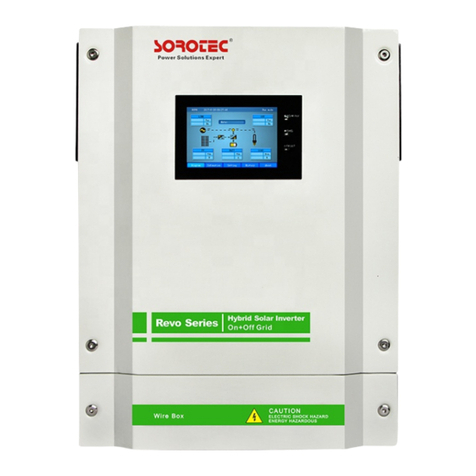
Sunways
Sunways REVO-II Series user manual

TECO
TECO L510-1P2-H1-N operating manual

Mitsubishi Electric
Mitsubishi Electric 800 Series instruction manual

Huawei
Huawei SUN2000-45KTL-US-HV-D0 user manual
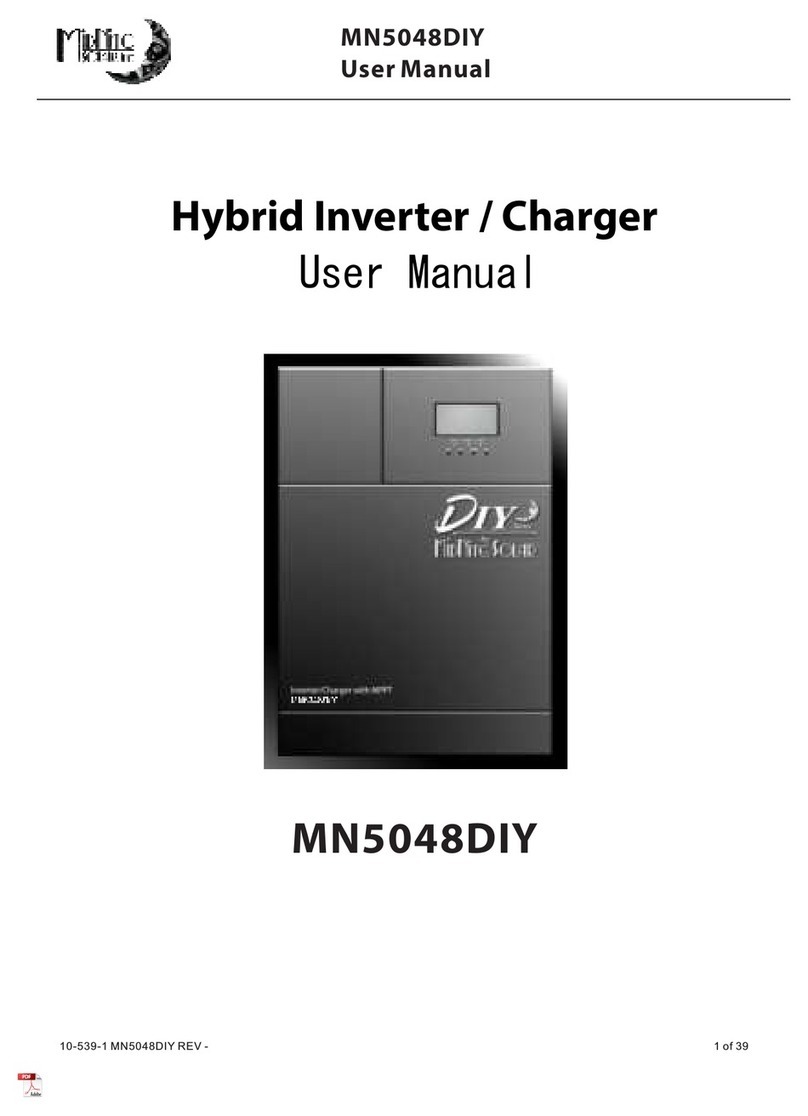
MidNite Solar
MidNite Solar MN5048DIY user manual
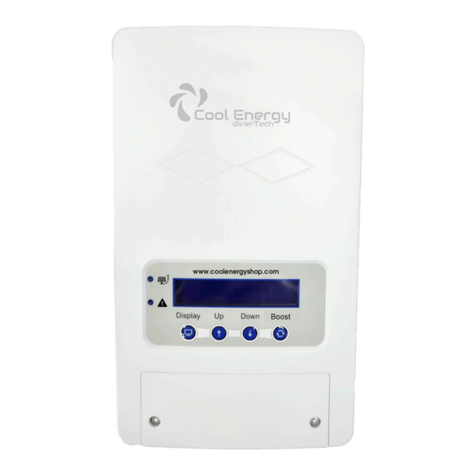
Cool Energy
Cool Energy diverTech Installation and user guide

